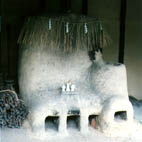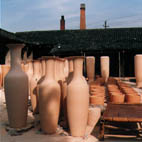









Hi Forrest!
It’s March, 1998.
Pink and white plum blossoms are in bloom and cherry blossoms are soon to follow. I have laundry hanging and futon mats sunning out on the veranda. And I’d like to tell you about where these months have taken me. It would be a bit much to ramble through it all, but let me tell you of my most recent visit to Okawachiyama in Imari City.
Imari is in Saga prefecture, west of Fukuoka on the island of Kyushu. Japanese porcelain is often referred to as Imari ware, but the actual production of these porcelains took place in nearby Arita and Okawachiyama. They were shipped abroad from the port of Imari, so they are generically referred to as Imari ware.
Historical background: During the Momoyama Period (1576 - 1600), Japan was unified and led by Oda Nobunaga and later by Toyotomi Hideyoshi. The Way of Tea or the tea ceremony had been practiced since the fifteenth century and Hideyoshi appointed Sen no Rikyu (1521 - 1591) as his tea mentor. Sen no Rikyu was the most famous and distinguished master o tea and his aesthetic choices greatly influenced Japanese aesthetics as a whole. For tea bowls, Rikyu preferred rough textures and irregular shapes over symmetrical forms and smooth surfaces. During his rule, Hideyoshi attempted to invade China and Korea. During his Korea campaigns of 1592 and 1597, Korean pottery was discovered and deemed very suitable for tea. This was during Korea’s Yi Dynasty. Pots from this time are also known as punch’ong ware and are characterized by their simple shapes and use of white slip. Hideyoshi and lords of Western Japan (now Kyushu) invited and also abducted Korean potters to work and build kilns in Japan. Some were given samurai status while others were prisoners. After Hideyoshi’s death in 1598, Japan entered the Edo or Tokugawa Period (1600-1867). This era was peaceful but it was also secluded. The Shogun (military leader) who this era is named after, Tokugawa Ieyasu, strictly limited trade with only the Dutch, Chinese, and Koreans. It was in the early Edo Period, in 1616, that a Korean potter named Ri Sampei first found kaolin in Arita.
The tourist’s brochure for Okawachiyama writes “Okawachiyama is enclosed on three sides by mountains. Thus, many people call it ‘The Village of the Secret Kilns’”. My friend’s guide book said something more along the lines of: Okawachiyama, surrounded by three crags, is where abducted Korean potters were once forced to work and live while the village was strictly guarded to prevent the spread of secret ceramic technical information.
Whichever is the case, the village of Okawachiyama is still very much surrounded by mountains which look more like lush cliffs. Even with today’s ease of transportation, it took a couple of train rides and a bus to reach the secret kilns. It is not difficult to imagine why this area was chosen to establish a furtive potters community. One of the first things to come in to view as you near the village is an area with hundreds of graves. Japanese grave stones are not as flat and wide as those in the U. S. Their proportions are more vertical, like square posts with wider blocks as the base. These graves (many anonymous) are the graves of potters from Korea and other countries.
Today, there are about twenty potteries in Okawachiyama. Most have shops with works on display for sale and studios attached somewhere in the back. Perhaps because of the nature of its origins, the village is very contained and shops and kilns are lined up next to each other along narrow sloping streets. Chimneys have the names of the potteries painted on top, so it’s easy to locate shops.
Most of the work is porcelain. Koishiwara and Onta adopted more of the Korean slip and inlay techniques while Okawachiyama was more influenced by celadons [a slow link, but worthwhile, ed.]. Celadons and porcelains were not of the tea ceremony aesthetic, but nevertheless, there was high demand for porcelain within and outside of Japan. In one building, there was a display of ores and minerals of the local area and there I saw a chunk of celadons. I never saw a celadon in a rock-like form before. For me, celadons was always a manmade glaze, a calculated mixture of feldspar, whiting, kaolin, zinc oxide, flint, red iron oxide, etc. It was very exciting to see celadons in its natural state. Another shop displayed a similar chunk, and it showed it ground, and then finally in the familiar milkshake consistency. I asked someone at the shop where they got their celadon from and she said, “Oh, right from that mountain over there”.
The other style of glazing that Okawachiyama is famous for is its Nabeshima ware. Nabeshima is the name of the clan which controlled the area in the seventeenth century. The technique used in Nabeshima ware is that of filling in blue underglaze outlines with bright overglaze colors of green, yellow, and red. Many of the patterns and designs are of berries, ferns, and flowers, some are very elaborate. Quite a contrast to the monochrome celadons.
In February, I went to Arita which is about twenty five minutes by train from Imari. As I mentioned before, this is where kaolin was first mined in Japan and it is still a huge porcelain producing area. There is less celadon at Arita and the ware is mostly colorful. Bright primary colored overglaze enamels are used with gold luster. A lot of the styled pottery is also known as Koimari or Old Imari. Is this getting confusing, yet? Arita also has the Kyushu Ceramic Museum that has a chart which chronicles Chinese, Korean, and Japanese ceramic histories. It also has a good permanent collection that shows old and contemporary ceramic works from all over Kyushu.
Recently, my advisor organized an exhibition in Fukuoka that showed three artists from Korea and three artists from Kyushu. The common theme was white slip. I saw this show a couple of weeks before going to Okawachiyama. Korea is indeed very close to Japan. I went skiing in Japan in January and the flight from Fukuoka to Seoul took a bit over an hour. There is a ferry that connects Pusan and Kyushu and that only takes three hours. I wonder how long the journey took for the potters nearly 400 years ago?
To totally change the subject, I wanted to share with you what has truly been comforting to have in Japan this winter: vending machines that roll out hot cans of coffee (black, with sugar, or with sugar and cream) and tea (Japanese blends, oolong, with lemon, or with cream and sugar). They’re perfectly hot. Not too hot to scorch your palette, but not luke warm, either. These vending machines are everywhere, at all train stations and along every other block. Hot cans are absolutely wonderful to have and to hold!
I’m hoping you’re well!
Angela
To briefly update you with where else I’ve been:
November � Jingdezhen, China. I met with friends Jessie Parker (now at the Archie Bray Foundation) and Jessica Jones (who was at the Ceramic Institute in Jingdezhen from September through February). Went to see a Sumo Tournament in Kyushu! Helped a friend set up a show in Kagoshima, Kyushu.
December � Tokyo for three weeks. Christmas in Yokohama. Helped set up a famous doll maker’s show in Ginza, Tokyo.
January � Rang in the New Year in Kyushu. Went skiing in Korea. Spent ten days in Kyoto. Saw Kawai Kanjiro’s House/Studio (now a memorial museum). Went to the pottery town of Tachikui.
February � Spent the first three weeks in Kagaji, a tiny village in Oita, and gave slide shows to each class at three elementary schools and one junior high school. Jessica Jones visited Kyushu on her way back to the U.S. after six months at Jingdezhen.
 Kanjiro’s Bisque Kiln
Kanjiro’s Bisque Kiln

 Outside of Kanjiro’s Studio
Outside of Kanjiro’s Studio


 Tile Wall in Arita
Tile Wall in Arita

 Jingdezhen, China
Jingdezhen, China
